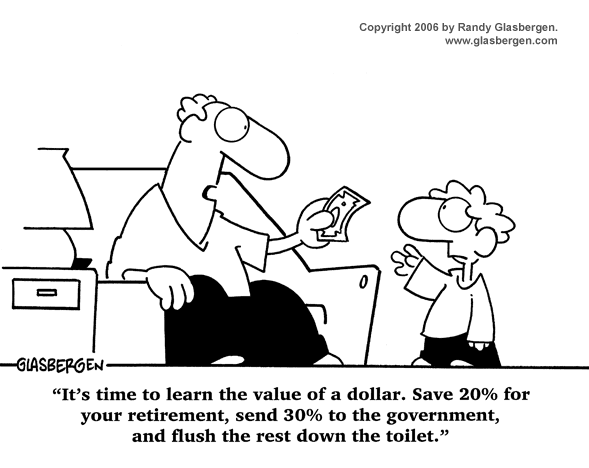

How Much Does It Cost?

I think that all of us in society often spend too much time worrying about how much something costs and don’t spend enough time thinking about whether we need something, and if we really do need it, the value of the item – not just its price. I think this is true about houses and cars and just about everything else we buy.
What we have clearly learned over the past years is that when comparing apples and oranges, you get different benefits for different costs and so looking only at the price is not always the best proxy for value. With that said, I am going to tackle the costs of pensions even though it is hard to exactly split out the 10 member DC plan apple from the Public Service DB plan orange. I acknowledge that challenge up front and so this commentary has its limitations, but directionally I think there is something to learn in the numbers that can be found. Unfortunately, the CPP’s unique partial funding model makes it more of a pear and as a result I am not going to focus on that program.
One of the main thrusts that the Ontario government is using to justify the Ontario Retirement Pension Plan (ORPP) is that it will be less expensive than private plans. Interestingly, one of the main thrusts in the three decade long transition from DB to DC has been that “DC is less expensive”. Notwithstanding the fact that private DC and DB plans and the ORPP and the CPP are all different animals, I wanted to pull together some numbers on ‘cost’ for comparison. Some argue that you should just compare investment costs since plans are different shapes and sizes which affect administration costs. But in the end, what matters to the accumulation of assets for retirement is the total cost of running the program – this is always the comparator used when talking about DC plans.
Public Service Pension Plans
Last week, the Fraser Institute released a research bulletin: Comparing the Costs of the Canada Pension Plan with Public Pension Plans in Ontario. If you want details, you can read the full report here so I am going to jump to the exciting conclusion: All in, Ontario’s public service plans are costing anywhere between 0.34% to 1.02% of assets to administer and invest. Compared to private sector DB and DC plans, this is not the bargain the average worker in Canada thinks that we are getting.
Interestingly, the $17.5 billion OPTrust comes in at the high end of the range at 1.02% while its sister plan, the Ontario Pension Board, with $22 billion, comes in at half that cost. In my days working for the Province of Ontario in the 1980’s, these plans were administered and invested together. It would be interesting to investigate how the split of the plans has resulted in such different costs – but that is a project for another day. Finally, the Healthcare of Ontario Pension Plan (HOOPP) with $61 billion comes in at a bargain of 0.34% or about a third of the OPTrust and about half of the $155 billion Ontario Teachers Pension Plan (0.63%).
I am not the sharpest mathematician in the crowd, but it is hard to see a strong correlation between the size of the fund and the costs to invest and administer the plan. Of course, performance will matter and on another day I will try to find the data to see if the plans that cost more are doing better with their investments – but my hunch is that investment outcomes are equally random.
Private DC Plans
In its December 2015 issue, Benefits Canada reported that Canada’s DC industry is now about $170 billion – certainly not loose change. In a letter to the editor in that issue, Tom Reid of Sun Life commented that “the average cost of a workplace retirement savings plan, which we administer, with more than 1,000 members is 40 basis points”. Of course, we care about the small plans too, so I reached out to Tom (and Kim Duxbury) at Sun Life and they confirmed that at Sun Life, DC plans with 250-999 members have an average fee of 70 bps and the majority of plans with as few as 50 members would have fees below 100 bps. Before you argue that Sun Life is the largest carrier and therefore that its costs are the lowest, the other DC providers aren’t going to be in business very long if they can’t be competitive so I am sure if we talk to all of them we will find an overall cost-effectiveness relative to the size of the plans that they administer and the services that they provide. This is fundamentally the thing I like most about leaving this industry in the hands of the private sector – competition and innovation.
Private DB Plans
We have to agree that small DB plans are the priciest of all. Actuarial work and pension administration including investments for a ‘small’ DB plan usually go over 1% and sometimes over 2%. That doesn’t mean there isn’t a place for a well designed DB plan that is efficiently run – it just means that the purpose of the plan has to be something other than setting aside and investing assets at the lowest cost. The Individual Pension Plan (IPP) is the best example of a plan that is costly to administer compared to a similar sized DC plan – but the IPP comes with tax advantages that for many sponsors/beneficiaries outweigh the extra costs.
It gets interesting when you get into larger DB plans. One of our clients sponsors a DB plan with hundreds of members and about $50 million in assets. The total cost for investment and administration is just over 1% – in the same range as the cost of operating the multi-billion dollar OPTrust. And for our client those costs are coming down as they just renegotiated their investment fees in a highly competitive environment.
What does it all mean?
The fact that at $50 million, a private DB plan starts to become as cost effective as big government DB plans doesn’t mean every employer will want a DB plan when they reach that size, and if cost is all that matters they can probably still do better in a DC plan. It does mean that once you get past a certain critical mass, whether you have $100 million, $10 billion, or $100 billion, costs don’t get substantially cheaper as you go up the line – and there is a variable that we don’t understand that actually causes costs to rise in larger plans. I have no evidence, but I worry that the hidden cost is driven by salaries for highly paid executives and investment professionals.
And what does this mean for the ORPP? It is too early to tell – but I continue to worry about costs. We have a three person board (I can’t find disclosure of their pay) and a chief executive earning about half a million dollars. Not a lot of money yet – but on the other hand, no assets whatsoever. Don’t worry, I am watching the costs because as I have said from the beginning – setting up a whole new plan is unlikely to deliver the cost advantages that the government is promising and that taxpayers expect and deserve.


